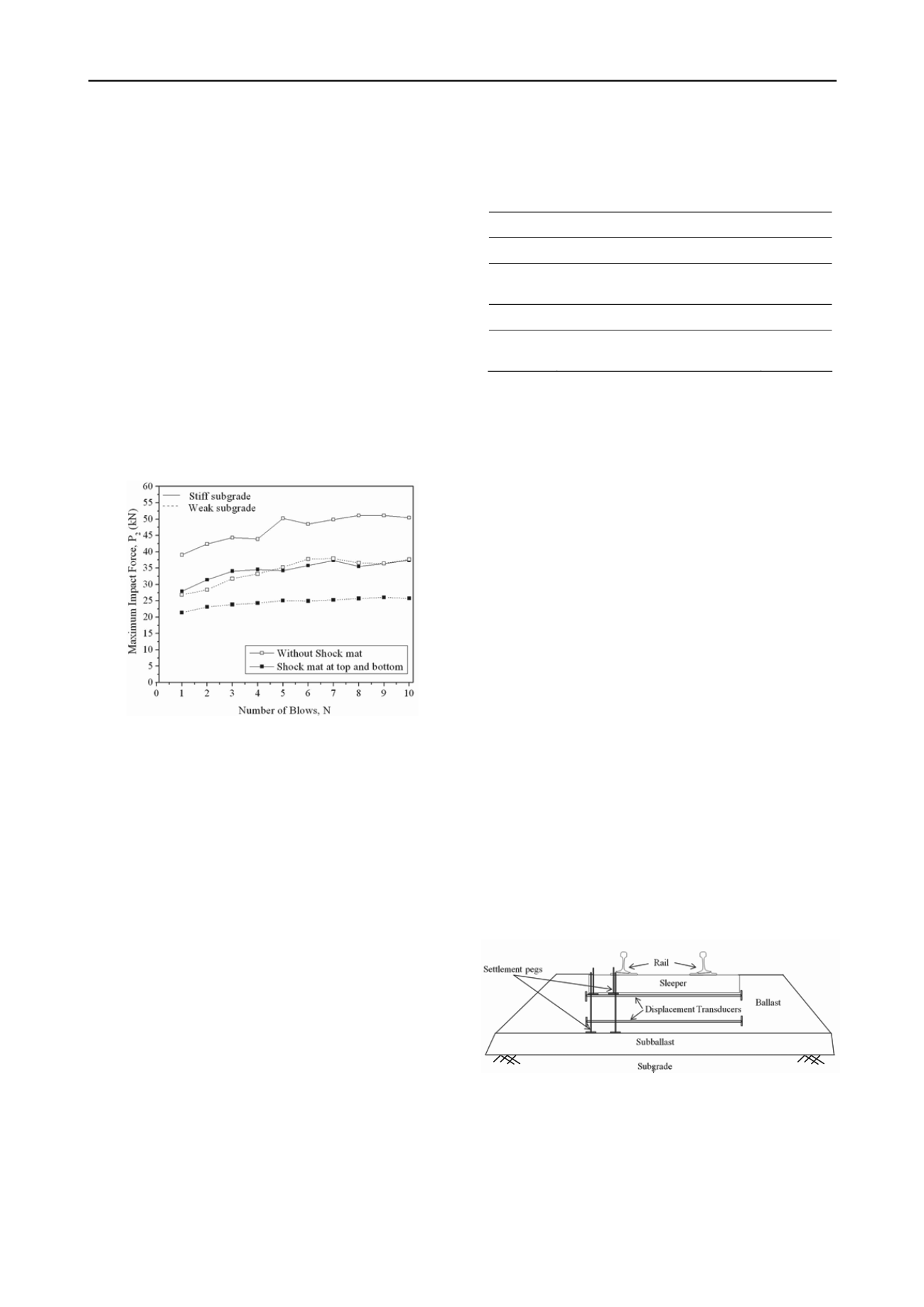
1284
Proceedings of the 18
th
International Conference on Soil Mechanics and Geotechnical Engineering, Paris 2013
2.1
Test setup and procedure
A steel plate of 300 mm diameter and 50 mm thickness was
used to represent a hard base such as the deck of a bridge, or
hard rock. A thick sand layer of 100mm thickness was used to
simulate a typical ‘weak’ subgrade. The drop hammer was
raised mechanically to the required height and then released by
an electronic quick release system. After 10 blows, an
attenuation of strains in the ballast layer was reached.
2.2
Single impact loading
The impact load-time history under a single impact load is
shown in Figure 1. Two distinct types of peak forces were seen
during impact loading: (a) an instantaneous sharp peak with
very high frequency
P
1
, and (b) a gradual peak of smaller
magnitude with a relatively smaller frequency
P
2
(Jenkins et al.
1974). It was also evident that multiple
P
1
type peaks followed
by the distinct
P
2
type peak often occurred. The multiple
P
1
peaks occurred when the drop hammer was not restrained
vertically, so consequently it rebounded after the first impact
and impacted the specimen again.
Figure 2. Variation of impact force with number of blows (data sourced
from Nimbalkar et al. 2012).
2.3
agnitude of impact force compared to a stiffer
, 2005, Lackenby et al. 2007, Indraratna and Nimbalkar
20
fo
ak sub
s that the weak subgrade itself
acts flexibl
Table 1. Ballas
ge under impact loading (Indraratna et al.,
2011a).
pe
Multiple impact loading
Figure 2 shows the variation of
P
2
force peak with repeated
hammer blows (
N
). The
P
2
force showed a gradual increase
with the increased number of blows due to the densification of
ballast. A dense aggregate matrix offers a higher inertial
resistance which leads to an increased value of
P
2
. Even without
a shock mat, a ballast bed on a weak subgrade leads to a
decreased m
subgrade.
2.4
Particle breakage
After each test, the ballast sample was sieved to obtain the
ballast breakage index (BBI) as shown in Table 1. The particle
breakage encountered under 10 impact blows was significantly
higher than that under both static and cyclic loads (Indraratna et
al. 1998
11).
The higher breakage of ballast particles can be attributed to
the considerable non-uniform stress concentrations occurring at
the corners of the sharp angular particles of fresh ballast under
high impact stresses. When a shock mat was placed above and
below the ballast bed, particle breakage was reduced by
approximately 47% for a stiff subgrade, and approximately 65%
r a we
as a
grade. This implie
e cushion.
t breaka
Base ty
Test Details
BBI
Stiff
Without shock mat
0.170
Stiff
Shock mat at top and bottom of
0.091
ballast
Weak
Without shock mat
0.080
Weak
Shock mat at top and bottom of
ballast
0.028
3 USE OF GEOSYNTHETICS FOR STABILISING A
BALLASTED TRACK: BULLI CASE STUDY
In order to investigate deformations of a
caused by train traffic, and the associat
multi-layer rail track
ed benefits of using
3.1
mposite layer were
the other two sections, fresh and
th a layer of geocomposite at the
The vertical and horizontal stresses induced in the track bed were
measured by pressure cells. Vertical deformations of the track were
measured by settlement pegs, and lateral deformations were measured
by electronic displacement transducers. The settlement pegs and
displacement transducers were installed at the sleeper-ballast and
ballast-subballast interfaces, respectively, as shown in Figure 3.
geosynthetics in fresh and recycled ballast, a field trial was
carried out on a fully instrumented track in the town of Bulli
north of Wollongong City [Indraratna et al. 2009, 2010]. The
proposed site was located between two turnouts.
Site geology and track construction
A site investigation comprising 8 test pits and 8 Cone Penetrometer
tests was carried out to assess the condition of the sub-surface soil
profiles. The subgrade consisted of a stiff over consolidated silty clay
that showed high values of cone resistance (
q
c
) and friction ratio (
R
f
)
(Robertson 1990, Choudhury 2006).
The instrumented section of track was 60 m long and it was
divided into four equal sections. The layers of ballast and
subballast (capping) were 300 mm and 150 mm, respectively.
Fresh and recycled ballast without a geoco
used in two sections, while in
recycled ballast was used wi
ballast-subballast interface. The physical and technical
specifications of the fresh ballast, recycled ballast and
geosynthetic material used at this site have been reported
elsewhere (Indraratna et al. 2011a, 2012a).
3.2
Track instrumentation
Figure 3. Installation of settlement pegs and displacement transducers at
Bulli site (data sourced from Indraratna et al. 2012b)


